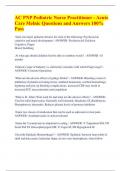AC PNP Pediatric Nurse Practitioner - Acute
Care Melnic Questions and Answers 100%
Pass
State one major pediatric theorist for each of the following: Psychosocial,
cognitive and moral development - ANSWER -Psychosocial: Erickson
Cognitive: Piaget
Moral: Kohlberg
At what age should children first be able to combine words? - ANSWER -18
months
Erikson's stage of Industry vs. inferiortiy coincides with which Piaget stage? -
ANSWER -Concrete Operations
What are the adverse effects of ginkgo biloba? - ANSWER -Bleeding events r/t
inhibition of platelet activating factor, subdural hematoma, cerebral hemorrhage,
hyphema and post-op bleeding complications, increased CBF may result in
increased ICP, may potentiate anticoagulation
What is St. John's Wort used for and what are the adverse effects? - ANSWER -
Used for mild depresssion, Generally well tolerated, Headache, GI disturbances,
Phytophotoxic dermatitis, Reduces plasma levels of protease inhibitors
Name two classes of medication that can be used as adjuvants to treat pain -
ANSWER -Antidepressants or anticonvulsants
Name the 5 cranial nerves important to eating - ANSWER -V Trigeminal SM, VII
facial SM, IX Glossopharyngeal SM, X Vagus M, XII Hypoglossal M
Describe Epidural Hemmorhages? - ANSWER -Epidural, between inner table of
skull and dura mater, lenticular shape, do not cross hemispheres, often follow
,middle meningeal artery tear, period of lucency followed by decreased LOA,
emergent surgical evacuation if symptomatic
Describe Subdural Hemmorhages? - ANSWER -Subdural, between dura mater
and arachnoid, may be associated with a skull fracture, often bilateral and will
cross hemispheres, symptoms may be acute or insidious ICP- surgical evacuation if
symptomatic
Describe subarchnoid hemmorhage? - ANSWER -Subarachnoid, between
arachnoid and pia mater, severe headache and neck pain, surgical evacuation if
symptomatic
"Name and describe the type of migraine typical to adolescence? - ANSWER -
Common migraine without aura, throbbing or pounding headache that is usually
unilateral, may have nausea and vomiting, often relieved by sleep
Summarize signs and symptoms of depression? - ANSWER -Usually coherent and
clear thinking, history of deterioration of scoial/school activities, weight gain/loss,
lethargic/apatheticvs anxious with angry outbursts, sleep disturbances, may have
suicidal ideation
Describe pertussis... course, diagnosis and treatment? - ANSWER -Course,
catarrhal phase, paroxysmal phase, convelescent phase. May have co-findings of
pneumonia, otits, seizures or encephalitis
Diagnosis- Lymphocytosis, Bordetella pertussis, a coccobacillus.
Treatment erythromycin
Review the signs, symptoms , and etiology of Guillain-Barre vs. Botulism -
ANSWER -Guillain-Barre' -- May follow non specific viral infection or
commonly, Campylobacter, Landry's ascending. Paralysis. CSF in notable for few
white cells and high protein. Botulism- Clostridium botulinum -A gram positive
Anaerobe. Rapid descending . Paralysis. CSF is normal. Avoid antibiotics
" - ANSWER -
, What is transient tachypnea of the newborn? - ANSWER -Usually follows
uneventful deliveries . May be related to slower absorption of fetal lung fluid
resulting. Decreased pulmonary compliance and increased dead space. Usually
resolves in approximately 3 days without therapy.
Review the criteria for ARDS - ANSWER -Acute onset of symptoms following,
precipitating infection of insult, frontal chest xray biliateral infiltrates. No clinical
evidence of LA HTN, PsO2 to Fio2 ratio </= 200
What are the radiologic findings for asthma? - ANSWER -Asthma, flattened
diaphragm, narrow cardiac silhouette, hyperinflation, narrow cardiac silhouette,
peribronchial thickening, subsegmental atelectasis
Describe methods to treat hyperkalemia - ANSWER -Push K into cells- Albuterol,
Insulin/glucose, Sodium bicarbonate - Remove K- Kayexalate, dialysis; Stabilize
cardiac cell membrane- Ca chloride
What is the equation to calculate creatinine clearance in children? - ANSWER -K
x ht (cm)/serum creatnine - K equals Preemie 0.33, Term 0.45, 2-21yrs female,
0.55 2-21 yrs male .70
Review the diagnostic criteria, treatment, and followup for urinary tract infection
in young children - ANSWER -Diagnostic Criteria- Unexplained fever( 2mos-
2yrs), + nitrite test, + leukoesterase test, 5 WBC's, Colony coutn > 100,000,
Culture of 2 or less organisms;
Oral treatment and followup- Amoxicillin, TMP/SMX, Cephalosporin-Treat for 7-
14 days US and VCUG to follow
Describe the signs and symptoms, lab findings, and treatment for nephrotic
syndrome - ANSWER -Signs and symptoms- edema, especially periorbital, HTN,
Anorexia, abd. Pain and or abd distension; Lab findings- Albumin < 2.5, Heavy
proteinuria, Cholesterol> 250, hematuria; Treatment-Steroids- Diuretics-
Sodium/fluid restriction, albumin




